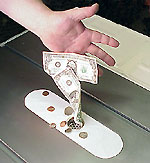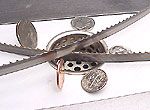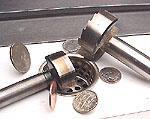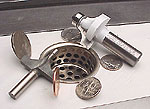This is a Veteran Owned site
Is Saving A Buck Costing You?Buying by price can bite you in the walletText and photos by Tom Hintz I hear it all the time. "Where can I buy (insert virtually any woodworking tool) that works as good as (insert any top-shelf brand version of the previous insertion) but get it really cheap?" Obviously, woodworkers are not alone in these cost saving efforts, but for our purposes here, they are the focus. Woodworking on a BudgetThe vast majority of woodworkers have to operate their home shops under the constraints of a budget. If you are one of the lucky few that can buy whatever and whenever you want, stop reading here. None of the following will make sense. Despite the passion with which many of us pursue woodworking, we have to remember that for most, it remains a hobby. That means the woodworking "want list" is a low priority item in most household budgets. And, as in most households, by the time you get that far down the expenditure list, there is seldom enough left to fully satisfy the need to buy tools, wood and supplies. The only alternatives are to buy less, or buy cheaper. The problem comes when buying cheaper to extend the budget overcomes common sense. This Ain't CharityThe first thing we have to realize is that when one product is priced considerably less than another similar product, there is an equally considerable reason for the disparity in cost. The companies producing woodworking products operate under the same corporate responsibilities as any other; they have to generate a profit to survive. This means that the only way to significantly lower the selling price is to reduce the costs of materials, production or both. Keep in mind that cost-cutting in either area has never been a celebrated way to improve the quality of the finished product. A prime example of a material cost with a direct impact on selling price is the carbide that tips so many of our cutting tools. While most of us routinely look for carbide-enhanced cutters, too many do not realize there are nearly as many varieties of carbide as there are woodworkers. Cheap carbide is in fact, still carbide, but costs far less than the top quality carbides that take and hold a sharp cutting edge several times longer than the cheaper variety. The bodies of most cutting tools, to which carbide is attached, can also be made from a wide range of metals. Here again, the quality of the metals used to fabricate the body can have significant effects on how the tool performs, and how long it will perform well. Lowering the price by using lesser quality metal usually reduces the effectiveness of the tool made from it. In addition to material quality, how a tool is produced also contributes to the final selling price. Even the high-buck manufacturing equipment used to make our tools comes in various price/quality levels. The machines that hold tighter tolerances while maintaining the capabilities necessary to produce a multi-faceted cutter edge cost considerably more to buy and operate than their cheaper, less accurate counterparts. Just as with materials, using cheaper machines and/or machining processes degrades the final quality and performance of the finished product. Buy Cheaper, Buy More OftenOne of the major problems with over-focusing on price when buying a tool is having to replace it more frequently. If the cheaper tool costs 50-percent less than one that lasts 200-percent longer, the "savings" are in the initial purchase only. After that, replacement costs guarantee spending far more than if the better quality tool had been purchased in the first place. Let's say you saved 50-percent by purchasing the cheaper version of a tool. You discover it didn't work well, and learning from the experience, buy the better version to replace it. You now find yourself in an odd position. You could have purchased the good quality tool initially, and then threw 50-percent of that price out of the car window on the way home and actually saved a little time without spending more money. Smart ShoppingCertainly there are deals on the tools and equipment we need in our shops. The trick is to find the best price on the best equipment we can afford. There will always be compromises when trying to operate a home shop within a budget, but that does not make purchase decisions based strictly on what's cheap any smarter. When I go to my local woodworking store, I generally leave with the items I really needed, but without some of the things I wanted. Though it occasionally feels like some kind of self-imposed torture, it really is simple fiscal responsibility. My family has grown accustomed to living indoors, and I assume would like to continue that. Some of the things I want for my shop have to wait until later. Advice and the New WoodworkerMaking sound purchasing decisions is often hardest for new woodworkers who lack experience using the tools. The proliferation of woodworking-related Internet forums is one resource new woodworkers turn to for advice. Like tools, the quality of the advice received can vary in quality. Experienced woodworkers tend to give advice that closely mimics their own purchasing attitude. The problem is that the person seeking advice may be operating in a very different fiscal environment than the person giving it. In addition, the new woodworker, being to some degree unfamiliar with the quality of various tools, may be looking to purchase the best they can afford, but be directed to something of considerably less quality. Conversely, new woodworkers sometimes ask advice trying to save money in a way those more experienced in the hobby know is not a good idea, possibly even dangerous. It would be most helpful for those offering advice to be reasoned in their recommendations, considering that the person asking for the advice may not fully understand the question. Clarifying the position of those seeking advice can make offering sound information much easier, and far more accurate. The good news for novice woodworkers is that there are many veterans who make a point of giving good advice and are willing to take the time to understand exactly what is being asked. That dedication serves not only the new woodworkers, but the hobby itself very well. Common Sense is KeyThis article is not meant to belittle value shopping. Most of us need to save money whenever we can. The key is spending our woodworking budget thoughtfully to prevent wasting money in an ill-advised attempt to save it. Look at all of the products available and weigh their individual benefits and liabilities, price included, and how they apply to your situation. The wide range of interests among woodworkers combined with individual preferences in their physical shops means a tool that is right for one may not be for another. Investing the time necessary to identify the right tool for your job can have a favorable effect on your budget later. There will be few occasions when buying better quality equipment does not translate into a cost savings in the long run. We may have to wait to make a purchase, but that patience converts to a larger tool-buying budget later. As we learn to prevent ill-advised over-spending, we get to spend more on the things we really want. Do you have a comment about this page? - Email Me!
|
All written, photographic and drawn materials are property of and copyright by NewWoodworker.com LLC 2000-2019. Materials may not be used in any way without the written permission of the owner.




